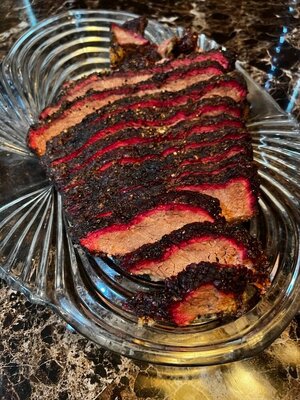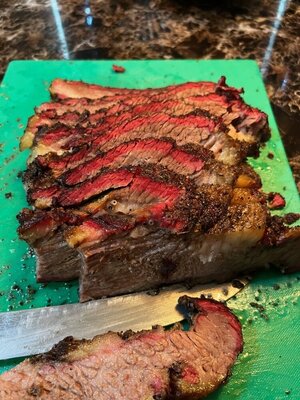Smoke vs Food Safety. Baseline facts:
Assumptions some of which are wrong I think but what I'm gathering from research:
Possible approaches:
- Steaks/roasts/chops need to be cooked to a minimum temperature of 145 according to FDA (https://www.foodsafety.gov/food-safety-charts/safe-minimum-internal-temperatures)
- Speaking about safety, not tenderness
- Starting a brisket off at lower temperatures will cause the brisket to remain below "safe" temperatures for a longer time, maybe too long.
- Z Grills says the smoke setting hovers between 158 and 194 and can only be used for an hour before cooking at a higher temperature. (https://help.zgrills.com/help-center/can-i-cook-on-the-smoke-setting/)
Assumptions some of which are wrong I think but what I'm gathering from research:
- Originally I thought the concern about bacteria multiplying was only a concern for the outside part of the meat, but I'm getting the impression now that the bacteria can multiply in meat below 140 even if outside of meat is at 140 due to outside temperature of the brisket inside the low cooking pit. In other words, having the pit above 140 is not enough to protect the meat if the meat takes too long to rise in temperature?
- Finishing the cook in wrapping paper will be important for tenderness?
- Fat won't properly render if it is not cooked at least part of the time at higher temperatures?
Possible approaches:
- Ignore manufacturer and put on super-smoke setting and let it fluctuate between 158 and 194 for maybe 8 hours or so, then wrap, increase temp and cook to 200 internal temperature.
- Super smoke for just 1 hour, then set to 195 and cook about 6 hours, wrap and continue cooking until it's about 200 internal temp
- Super smoke for 1 hour, then cook at 195 until it reaches 145 internal temp, then reduce pit back to super-smoker setting for a number of hours to maximize smoke, then wrap, then cook for several more hours.
- Will fat fully/completely render if the roast is cooked at 190 the whole time or will the rendering be incomplete no matter how long you cook it?
- Will the roast ever reach a temperature ABOVE the actual temperature of the pit, for instance if I smoke at 195 the whole time will the meat ever reach 200?
- Which of the above 3 approaches would you recommend for maximum smoke while not taking too much safety risk?









